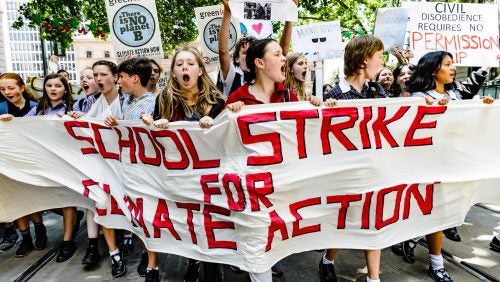Silencing Children in the Face of Climate Catastrophe
February 10, 2020 by Molly Green

Do children have a right to a government that protects their interest in a sustainable climate? Will Courts give them a chance to voice the urgency of their climate-based claims?
In 2015, a group of young environmental activists ranging in age from eight to nineteen, brought an action for declaratory and injunctive relief against the Government of the United States, the President, and various executive agencies, claiming that the destabilized climate system caused by increased greenhouse gas emissions in the U.S. violated their substantive due process rights.[1] The plaintiffs, most of whom were too young to vote at the time, asserted that the government took affirmative actions to cause climate change and in doing so violated the younger generation’s constitutional rights to life, liberty, and property.[2] As a remedy, the plaintiffs asked the court to order the federal government to develop and implement a science-based national plan that would place the U.S. on an emissions cutting pathway consistent with a 1 degree Celsius and 350 ppm CO2 target.[3] The plaintiffs relied on a recent report by energy experts illustrating that the remedy they sought is economically feasible, and the scale and speed of the emissions reductions is possible.[4]
The district court in Oregon, where the case was brought, denied the government’s motion to dismiss and concluded that the plaintiffs had standing and successfully stated a claim for a violation of a constitutional due process right to a climate system capable of sustaining human life.[5] The court went on the define that right as one to be free from substantial damage to the climate system “in a way that will cause human deaths, shorten human lifespans, result in widespread damage to property, threaten human food sources, and dramatically alter the planet’s ecosystem.”[6]
After the district court denied its motion to dismiss, the government petitioned for interlocutory appeal in the 9th Circuit, which the court granted. On January 17th, the 9th Circuit issued an opinion reversing the district court and dismissing the plaintiffs’ case in a 2-1 split decision.[7]
The appellate court’s reversal is not entirely surprising. The plaintiffs were asking the federal court to recognize a new constitutional right to a stable environment. Given the current makeup of the Supreme Court, the plaintiffs’ chances of succeeding all the way through to the highest Court were always slim.
Interestingly, however, the 9th Circuit did not dismiss the case for failure to state a claim nor did it outright refuse to acknowledge the plaintiffs’ proposed constitutional right to a stable climate. Instead, two of the three judges on the panel dismissed the case due to lack of standing.[8] Despite Supreme Court precedent recognizing a cause of action and legal standing under climate change issues,[9] the court concluded that the plaintiffs failed to demonstrate that the injunctive relief they sought was within the power of an Article III court, and therefore failed the redressability element for Article III standing.[10] Although it ultimately dismissed the case, the majority addressed the severity of the climate issues raised by the plaintiffs. Judge Hurwitz, who wrote the majority opinion, acknowledged that the plaintiffs had presented compelling evidence that climate change has brought the “eve of destruction” nearer, and that the federal government hastened an “environmental apocalypse” through promotion of fossil fuel use.[11]
In a strongly worded dissent, Judge Staton urged that “considering plaintiffs seek no less than to forestall the Nation’s demise, even a partial and temporary reprieve would constitute meaningful redress.”[12] She goes on to argue that where the nation or the Constitution is threatened, it is the responsibility of the courts to take action, and while a decision for the plaintiffs may only represent a drop in the bucket, those drops matter significantly when we are “perilously close to an overflowing bucket.”[13]
In short, the appellate court’s majority opinion seemed to accept as true nearly every point made by the plaintiffs, yet it told them to seek relief from the political branches because they cannot get it from the judiciary. The decision makes clear that future generations cannot turn to the courts to address their climate concerns. Considering those under the age of eighteen aren’t able to vote and therefore have a limited voice in the political branches, this decision could effectively silence the younger generation from seeking legal redress on their own behalf concerning climate change, despite the fact that they will feel the effects of climate change most drastically. With this decision, the judiciary has affirmatively taken a step to remove itself from the fight against climate change.
[1] Juliana v. United States, 217 F.Supp.3d 1224 (D. Oregon 2016).
[2] Our Case, YouthVGov https://www.youthvgov.org/new-folder.
[3] 350 PPM Pathways, Our Children’s Trust https://www.ourchildrenstrust.org/350-ppm-pathways.
[4] Id.
[5] Juliana at 1250.
[6] Id.
[7] Juliana v. United States, No. 18-36082, 1010 WL 254149 (9th Cir. 2020).
[8] Id.
[9] Massachusetts v. EPA, 549 U.S. 497 (2007).
[10] Juliana v. United States, 2020 WL 254149 at *2.
[11] Id.
[12] Id. at 11.
[13] Id. at 16.

